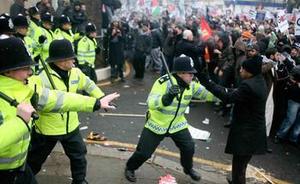Law enforcement technologyLondon police use smartphones, social network to identify rioters
The rioters in London — and now, in other British cities — have been using Blackberries to outmaneuver the police; communicating via BlackBerry instant-message technology, as well as by social networking sites like Facebook and Twitter, the rioters repeatedly signaled fresh target areas to those caught up in the mayhem; RIM has now agreed to cooperate with Scotland Yard to turn over protestors using the service to coordinate their assaults; the police is also releasing CCTV images of the rioters to a group using face recognition technology to identify and condemn rioters; the police is also using Flickr, Tublr, and Twitter to spot and identify participants in the riots

London police have been using the same social media // Source: sodahead.com
Smartphones, especially Blackberries, have been a helpful information transmission and coordination tool for anti-government activists in a score of Arab countries – and they have played a major role in helping the rioters in London and other British cities coordinate their assaults and evade the police.
Here is how the New York Times saw it:
Despite an additional build-up in the number of riot police officers, many of them rushed to London from areas around the country, gangs of hooded young people appeared to be outmaneuvering the police for the third successive night. Communicating via BlackBerry instant-message technology that the police have struggled to monitor, as well as by social networking sites like Facebook and Twitter, they repeatedly signaled fresh target areas to those caught up in the mayhem.
For a more detailed report on the use of Blackberries by the London rioters, see this Digital Trends’ article.
DT notes that RIM is not the only company help the police authorities identify the rioters. Google Groups has its own mechanism for identifying guilty parties. A Group called London Riots Facial Recognition has been started, and members want to use face recognition technology to identify and condemn rioters. The group, using public and legal images, insists its actions are legal. The group’s mission statement explains: “The police are giving us access to CCTV images of the rioters and looters. Let’s use existing technology like facial recognition and social networks proactively to help the justice process happen a little quicker.”
See this DT report on how the police is using sites like Flickr, Tumblr, and Twitter to identify rioters
